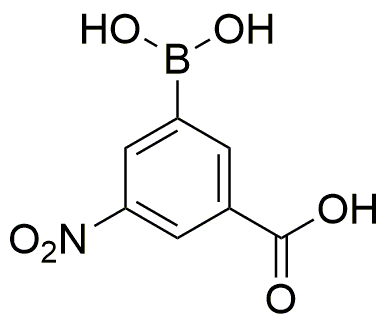3-Carboxy-5-nitrophenylboronic acid is widely utilized in research focused on:
- Drug Development: This compound serves as a key intermediate in the synthesis of various pharmaceuticals, particularly in the development of targeted therapies for cancer treatment.
- Bioconjugation: It is used in bioconjugation processes, allowing researchers to attach biomolecules to surfaces or other compounds, enhancing the effectiveness of drug delivery systems.
- Sensor Technology: The compound is applied in the creation of chemical sensors that detect specific biomolecules, aiding in diagnostics and environmental monitoring.
- Organic Electronics: Its unique properties make it suitable for applications in organic electronics, such as organic light-emitting diodes (OLEDs), improving device efficiency.
- Research in Catalysis: This chemical is also explored in catalytic reactions, where it can enhance reaction rates and selectivity, offering advantages over traditional catalysts.
General Information
Properties
Safety and Regulations
Applications
3-Carboxy-5-nitrophenylboronic acid is widely utilized in research focused on:
- Drug Development: This compound serves as a key intermediate in the synthesis of various pharmaceuticals, particularly in the development of targeted therapies for cancer treatment.
- Bioconjugation: It is used in bioconjugation processes, allowing researchers to attach biomolecules to surfaces or other compounds, enhancing the effectiveness of drug delivery systems.
- Sensor Technology: The compound is applied in the creation of chemical sensors that detect specific biomolecules, aiding in diagnostics and environmental monitoring.
- Organic Electronics: Its unique properties make it suitable for applications in organic electronics, such as organic light-emitting diodes (OLEDs), improving device efficiency.
- Research in Catalysis: This chemical is also explored in catalytic reactions, where it can enhance reaction rates and selectivity, offering advantages over traditional catalysts.
Documents
Safety Data Sheets (SDS)
The SDS provides comprehensive safety information on handling, storage, and disposal of the product.
Product Specification (PS)
The PS provides a comprehensive breakdown of the product’s properties, including chemical composition, physical state, purity, and storage requirements. It also details acceptable quality ranges and the product's intended applications.
Certificates of Analysis (COA)
Search for Certificates of Analysis (COA) by entering the products Lot Number. Lot and Batch Numbers can be found on a product’s label following the words ‘Lot’ or ‘Batch’.
*Catalog Number
*Lot Number
Certificates Of Origin (COO)
This COO confirms the country where the product was manufactured, and also details the materials and components used in it and whether it is derived from natural, synthetic, or other specific sources. This certificate may be required for customs, trade, and regulatory compliance.
*Catalog Number
*Lot Number
Safety Data Sheets (SDS)
The SDS provides comprehensive safety information on handling, storage, and disposal of the product.
DownloadProduct Specification (PS)
The PS provides a comprehensive breakdown of the product’s properties, including chemical composition, physical state, purity, and storage requirements. It also details acceptable quality ranges and the product's intended applications.
DownloadCertificates of Analysis (COA)
Search for Certificates of Analysis (COA) by entering the products Lot Number. Lot and Batch Numbers can be found on a product’s label following the words ‘Lot’ or ‘Batch’.
*Catalog Number
*Lot Number
Certificates Of Origin (COO)
This COO confirms the country where the product was manufactured, and also details the materials and components used in it and whether it is derived from natural, synthetic, or other specific sources. This certificate may be required for customs, trade, and regulatory compliance.


